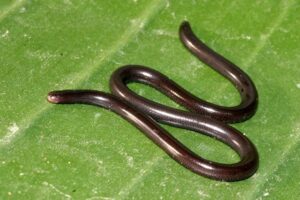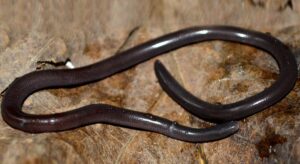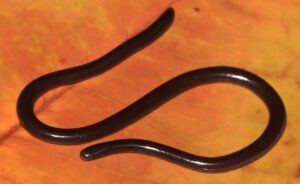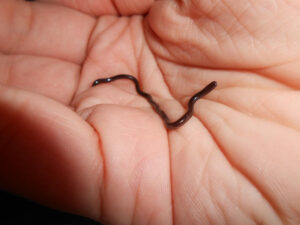The Brahminy blind snake is a fully fossorial snake commonly found in Asia and Africa but introduced in many other parts of the world. They are often mistaken for earthworms as they resemble them in their habits and appearance. But closer examination reveals tiny scales rather than annular segments as is characteristic of earthworms. The specific name, braminus, is the Latinized form of Brahmin.
Other names of the Brahminy blind snake include common blind snake, flowerpot snake, teliya snake, island blind snake, and Hawaiian blind snake. The name flowerpot snake stems from the fact that snake was introduced in different parts of the world through the plant trade.
Scientific Classifications
- Suborder:Serpentes
- Family:Typhlopidae
- Genus:Indotyphlops
- Species:I. braminus
Conservation Status
Description
Size
The full-grown snakes are 2-4 in (5.1-10.2 cm) long. It is uncommon for them to reach 6 in (15 cm), making them the smallest snake species.
Color and Appearance
The body color can be silver-gray, charcoal-gray, purplish, light yellow-beige, or infrequently, they can even have albinism. The ventral surface is paler. The juveniles are similar in color to the adults.
The head and tail look similar as they are indistinct. The head scales resemble the body scales, unlike other snakes. The end of the tail has a small, pointed spur. There are fourteen rows of dorsal scales along the body.
The eyes can barely be seen as they are tiny dots under the head scales. They are covered with translucent scales, rendering the snakes almost entirely blind. Though the eyes cannot form images, they are capable of registering light.
Are They Dangerous to Humans
If approached or uncovered, the shy Brahminy blind snake tries to escape by burrowing. On being captured, it presses its harmless tail tip against the attacker and releases a foul-smelling musk from a pair of glands at the base of its tail. It doesn’t bite in defense.
Brahminy Blind Snakes at a Glance
Distribution
Though thought to be a native of Asia and Africa, it has been introduced in many parts of the world, including the Americas, Australia, Europe, and Oceania. Its vertical distribution is from the sea level to 3900ft (1200 m) in Sri Lanka and up to 4900ft (1500 m) in Guatemala. Its type locality is Vishakhapatnam, India.
Habitat
The Brahminy blind snake inhabits agricultural and urban areas. It lives underground in termite and ant nests. It is also found under moist leaves, logs, humus, and stones in dry jungles, wet forests, abandoned buildings, and city gardens. Their survival and range directly reflect the soil temperature and humidity.
Their energy levels range from energetic to lethargic, with the snakes quickly seeking the cover of leaf litter and soil to avoid light.
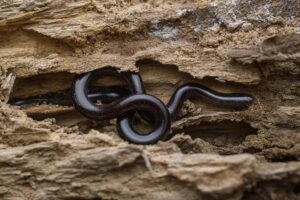
Lifespan
Their lifespan is unknown.
Predators
It is easily eaten by many predators like monitors, birds, and other snakes, like the red-tailed pipe snake.
Diet
Their diet is formed of pupae, larvae, and eggs of ants and termites.
Reproduction
Oviparous (lays eggs that hatch outside the body)
They are parthenogenetic, with all individuals being females. 1-8 unfertilized eggs are laid in a clutch.
Source
inaturalist.org, indiabiodiversity.org, springernature.com, thainationalparks.com, deviantart.com

